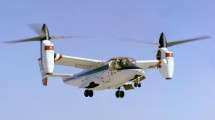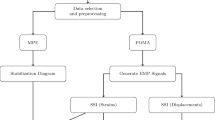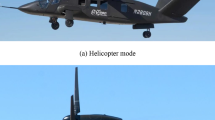Abstract
The whirl flutter phenomenon in a rotor is induced by in-plane hub forces, and imposes a serious limit on the forward speed. In this paper, based on Greenberg’s model, quasi-steady and unsteady aerodynamic forces are formulated to examine the whirl flutter stability for a three-bladed rotor without flexible wing modes. Numerical results are obtained in both time and frequency domains. Generalized eigenvalue solution is utilized to estimate the whirl flutter stability in the frequency domain, and Runge-Kutta method is used to analyze it in time domain. The effects of varying the pylon spring stiffness and the swashplate geometric control coupling upon the flutter boundary are investigated. An optimum pitch-flap coupling parameter is discovered through the parametric study. Aeroelastic stability boundaries are estimated with the three different aerodynamic models. It is found that the analysis with the full unsteady aerodynamics predicts the highest flutter speed.
Similar content being viewed by others
References
E. S. Taylor and K. A. Browne, Vibration Isolation of Aircraft Power Plants, Journal of the Aeronautical Sciences, 6(2) (1938) 43–49.
W. E. Jr. Hall, Prop-Rotor Stability at High Advance Ratios, Journal of the American Helicopter Society, 11(2) (1966) 11–26.
R. G. Kvaternik and J. S. Kohn, An Experimental and Analytical Investigation of Proprotor Whirl Flutter, NASA Technical Paper-1047, (1977).
C. W. Acree et al., Rotor Design Options for Improving XV-15 Whirl-Flutter Stability Margins, NASA Technical Paper-2004-212262, (2004).
M. W. Nixon et al., Tiltrotor Vibration Reduction Through Higher Harmonic Control, American Helicopter Society 53rd Annual Forum [CD-ROM], Virginia Beach, Virginia, April 29–May 1, (1997).
R. G. Kvaternik et al., An Experimental Evaluation of Generalized Predictive Control for Tiltrotor Aeroelastic Stability Augmentation in Airplane Mode of Flight, American Helicopter Society 57th Annual Forum [CD-ROM], Washington, DC, May 9–11, (2001).
R. Singh and F. Gandhi, Wing Flaperon and Swashplate Control for Whirl flutter Stability Aug mentation of a Soft in-plane Tiltrotor, The 31st European Rotorcraft Forum [CD-ROM], Florence, Italy, Sept. 13–15, (2005).
W. Johnson, Dynamics of Tilting Proprotor Aircraft in Cruise Flight, NASA Technical Note D-7677, (1974).
R. L. Bisplinghoff, H. Ashley and R. L. Halfman, Aeroelasticity, Dover, New York, (1996), Chap. 6.
J. M. Greenberg, Sinusoidal Motion in Pulsating Stream, NASA TN 1326, (1947).
C. E. S. Cesnik, 16.242 Aeroelasticity, Lecture Note, Department of Aeronautics and Astronautics, Massachusetts Institute of Technology, Cambridge, Massachusetts, (1998).
M. A. H. Dinyavari and P. P. Friedmann, Application of Time-Domain Unsteady Aerodynamics to Rotary-Wing Aeroelasticity, AIAA Journal, 24(9), (1986) 1424–1432.
R. T. Jones, The Unsteady Lift of a Wing of Finite Aspect Ratio, NACA Report 681, (1940).
R. T. Jones, Operational Treatment of the Nonuniform Lift Theory to Airplane Dynamics, NACA TN 667, (1938).
P. P. Friedmann and L. H. Robinson, Influence of Unsteady Aerodynamics on Rotor Blade Aeroelastic Stability and Response, AIAA Journal, 28 (10) (1990) 1806–1812.
W. Johnson, Analytical Modeling for Tilting Proprotor Aircraft Dynamics Including Blade Torsion and Coupled Bending modes, and Conversion Mode Operation, NASA TM X-62, 369 (1974).
M. W. Nixon, Aeroelastic Response and Stability of Tiltrotors with Elastically-Coupled Composite Rotor Blades, Ph.D. Thesis, University of Maryland, (1993).
E. L. Hathaway, Active and Passive Techniques for Tiltrotor Aeroelastic Stability Augmentation, Ph.D. Thesis, The Graduate School College of Engineering, The Pennsylvania State University, (2005).
D. M. Maisel et al., The History of the XV-15 Tilt Rotor Research Aircraft: From Concept to Flight, NASA SP-2000-4517, (2000).
Author information
Authors and Affiliations
Corresponding author
Additional information
This paper was recommended for publication in revised form by Associate Editor Hong Hee Yoo
Taeseong Kim received his B.S. in Aerospace Engineering from Korea Aviation University, Korea, in 2004. He then received his M.S. and Ph.D. degrees from Seoul National University in 2006 and 2009, respectively. Dr. Kim is currently a Research Scientist at Wind Energy Division at Risø National Laboratory for Sustainable Energy in Roskilde, Denmark. His research interests include aeroelasticity, wind turbine dynamics, rotorcraft dynamics, and structural dynamics.
SangJoon Shin received S.M. and Ph.D. degrees in Aeronautics and Astronautics from Massachusetts Institute of Technology in 1999 and 2001, respectively. From 1991–1996, he worked at the Helicopter Systems Department, Korean Agency for Defense Development. From 2001–2003, he worked at the Department of Aerospace Engineering, University of Michigan, Ann Arbor. Since 2003, he has been a professor at the School of Mechanical and Aerospace Engineering in Seoul National University. His research interests include aeroelasticty, rotorcraft dynamics, and smart structures.
Taehyoun Kim earned a Ph.D. in Aeronautics and Astronautics from Massachusetts Institute of Technology in 1992. Since 1996 he has worked in Loads and Dynamics Group of Boeing Commercial Aircraft, Seattle, Washington, USA. Prior to joining the Boeing Company he worked in Computational Mechanics Laboratory at Georgia Institute of Technology. Since 2005, he has been teaching a short course, “Computational Methods in Aeroelasticity” at SDM Conference, Boeing Ed Wells, National Aerospace Laboratory in India, and NASA Langley. Dr. Kim’s specialties are aeroservoelasticity/structural dynamics, computational and experimental methods in aeroelasticity, system identification and model reduction of large-scaled dynamic systems, and composite structures.
Rights and permissions
About this article
Cite this article
Kim, T., Shin, S. & Kim, T. Analysis of tiltrotor whirl flutter in time and frequency domain. J Mech Sci Technol 23, 3281–3291 (2009). https://doi.org/10.1007/s12206-009-1002-3
Received:
Revised:
Accepted:
Published:
Issue Date:
DOI: https://doi.org/10.1007/s12206-009-1002-3




